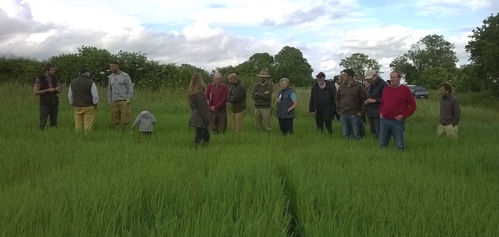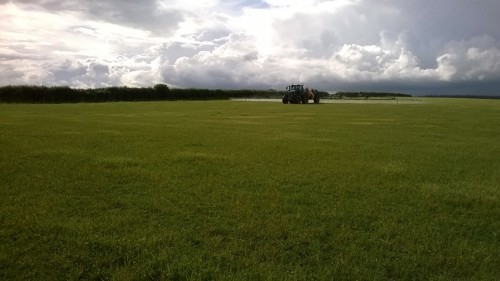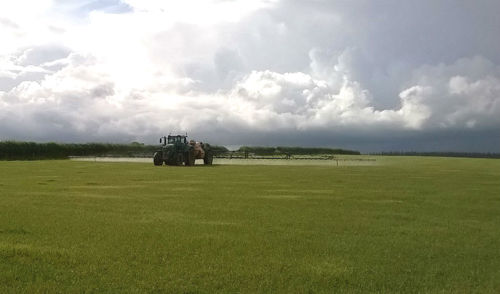





This field lab investigated the impacts of compost tea on crop health and yield and on soil microbiological communities, building on a previous field lab from 2014-2016
The aims of the field lab were:
1) To identify best practice methods for making and applying compost tea on farm.
2) To assess the effect of compost tea application on the populations of microbiological life in the soil and to characterise these microbial communities.
3) To assess the effect of compost tea application on crop development, health and yield.
There has been considerable interest in recent years in using compost teas, which are claimed to increase yields and suppress disease. There has been research in Europe but little is known in UK systems.
The application of compost tea to a spring cereal crop is thought to increase the soils microbial biomass (as total microbial biomass, and the biomass of fungi, bacteria, protozoa and mycorrhizae individually) and activity (respiration), and alter its community’s functional and phenotypic profile. It is also thought to increases crop health, yield and quality.
It is hoped that the field lab will establish the best methods for on-farm making of compost, brewing and applying at farm-scale to help more farmers improve their soils and yields.
1. Compost was made and compost tea brewed on site. The trialists applied a series of 3 compost tea brews to a trial arable field and looked for the microbial benefits in the soil. A range of crop traits were also analysed including establishment and yield.
2. Soil samples will be taken before and after compost tea application to determine any changes to soil microbiology.
3. Crops will be assessed for various traits including crop phenology, establishment, root growth, height, crop disease, tillering, yield (grain and biomass) and grain quality (specific weight and protein) to investigate whether compost tea application has had any effect.
A full overview of the trial and results can be found on the results and reports section of the field lab page.
At the meeting in March, an overview of the field lab (including both the first and second trials - over 3 years) was discussed.
The 2017 trial was made more scientifically robust following promising initial results from the previous years more 'look-see' approach. The trial used 12 replicated strips in 2 fields, and there was more analysis of both the brew and the soil. Although not statistically significant, there was an upward trend in active bacteria in soil samples over time compared with the control, and a slight increase in fungal levels. Despite this, there was no significant yield increase. No effects of the compost tea's ability to suppress fusarium were able to be well ascertained, as the control samples had no traces of the disease either.
All analysis from Cranfield University which involved phospholipid fatty acid analysis, substrate induced respiration, and microbial biomass showed a lack of statistical response to compost tea application. However, analysis did show that the brewer was multiplying bacteria but reducing fungi. It was also felt that the brew was weak which has raised questions about the brewing technique, water, compost and sprayer.
The triallist explained that her view was that all farms need to do some experimentation, and her initial capital investment was for that purpose. In 2015 the cost of compost and catalyst was £18.82 per hectare, which reduced to £11.32 in 2017 when she used her own compost this required a 3% yield increase to justify.
Her view was that this was less than compost for the whole farm would cost, and compost tea can cover a much larger area than spreading compost, however the compost tea was only as good as the compost it is made from.
Compost tea analysis had showed that there was no change to the microbiology from passing through the sprayer but the cleaning process, particularly the water usage, made it unviable. The sprayer was a contractor’s and his investment in a new one meant that the trial would not continue at this site. Other farmers using compost tea who have their own sprayer are able to by-pass this issue, although it may be a question of investment in equipment.
There were also questions raised about whether there was no response because the soil was already at optimum levels, but also whether there would be different responses where different levels of soil organic matter were found such as where compost, digestate, cover-crops or non-inversion techniques were used- this could be worth further study.
The other area of interest would be where compost tea is used in a fungicidal capacity, to see if the reduction in Fusarium shown in 2016 was due to the compost tea application. Reducing late season ear disease, or reducing the need for a seed treatment would have longer term benefits.
Stephen has been using compost tea over 20 – 40 acres for 3 years, applying it to half a field on cereals (wheat or oats) and the other half without an application (control area). He has applied the CT in the agroforestry area but not actually on the apple trees. He hasn't thought about using CT as a disease protection for the trees as there hasn't been any disease, so there’s no need.
We asked Stephen the following questions:
Have you used your own compost to make it and has it been inoculated with microbes (local, bought in)?
First year we used Laverstoke compost inoculator, monitored and no results in terms of yield, soil analysis showed no difference, 2nd year similar results but fungal dominated soil. Compost starter was also dominant in fungi – which is probably why we aren’t seeing a result. We realised this and made own compost in third year, tried to make bacterial dominated. Our sticking point is – how to make a good quality reliable robust bacteria dominated compost.
In the first year of using CT we were trying not to wreck it, in the 2nd year trying to get applications right and in the 3rd thinking on how to better it.
What was the compost made with?
We used grass cuttings and clover (high N), woodchip and bought in manure. Woodchip is from our own apple prunings, the manure a mix of our own animals and that from a local organic dairy herd in small quantities.
Have you had any practical problems with the compost or compost tea production / applying it?
"Basically we don’t know if were doing it right, it’s easy enough to make. For only 40 acres it is manageable, but to make it for 100 acres would be much more challenging. We can’t get to heat up enough and it needs constant turning, keeping the temperature and moisture right is an ongoing issue. The batch is small - a couple of m2, therefore the pile cools quickly. If it was a bigger industrial size it would probably be much easier to retain heat. We don’t have enough concrete so it’s just on ground (which can sap the heat).
In the first year there were blockages in sprayer – this was easy to solve with different nozzles and filters. I should say – my feeling is to use the sprayer properly needs a certain level of pressure, but could be detrimental to the microorganisms. I have seen a very expensive NZ applier – it doesn’t pressure up but pushes through mini-splash plates, which then avoids this potentially compromising effect. Crop sprayers are built for pressure, but as we’re applying living biology it likely unsurprisingly doesn’t like pressure! I’m looking at investing but it’s hugely expensive."
We’ve been trying to use rain water where possible as tap water is too high in chlorine. We've only used the sprayer for CT so didn’t need to clean it very often. We used all-clear at the beginning and end of the applications, but avoid cleaning otherwise. Our 12l sprayer quite small, so it is easier to flush out. We avoid putting too many cleaning agents through it."
Have you taken any measurements before, during and after using it / compared to a control / without any cover crops etc.?
"Soil biological analysis has been done through SoilBioLab and we've done some looking through microscopes but are not seeing any major differences. For the future we've got to get better at bacterial dominated compost – that’s the killer question."
Paul has been applying CT for 2 years, and has had the vineyard for 3 years. He has been using bought in compost as it is easier. He used to make his own one-year matured compost, however now it’s difficult finding the time to do so.
Paul's thoughts on his CT use:
It’s going well and he has picked his first vine crop this year. He’s been using a small 100 l brewer and a sprayer to apply it. The sprayer is also used for normal / other sprays, but Paul thinks there are no interference / negative contamination effects. This is because the other products he uses with the sprayer also include ‘live’ products.
He tends to rotate his applications between 1 week of plant protection products and then 1 week of nutrient foliar spray. "It’s hard to say if there has been a clear effect as I spray the lot without a control area. I believe in it, which is why I spray the lot.” Visitors have commented that it looks very healthy, as has the agricultural advisor, who advises on vineyards including organics. He knows a lot of farmers that use CT because they’re organic.
"I make the brew 24 hrs before applying it. Applications are only from March – end of October. The vineyard is dormant over winter. Between the vineyard rows I have mixed grass and natural regenerated grass cover. I also grow dedicated chicory and sainfoin – basically because I had a bag left over so thought give it a try. The chicory has long tap roots that I think will bring up different nutrients and it’s quite vigorous. This competitiveness will help against the vines later – it’s good to have some of this to take excess vigour out for fruit ripening."
The compost tea group, including additional farmers interested in the trial, met at Hemsworth Farm to discuss results of this year's soil microbiology. A presentation was also given to show the previous two year's results to compare.

Dominic (ORC) and Simon (SoilBioLab) presented previous years results, followed by Mark (Cranfield University) who presented this year's soil microbiology analysis. Results were not as expected - there is no evidence to suggest compost tea has affected the soil community. Following this, there was discussion over the length of time needed for compost tea to have an effect in soil. There was also a lot of discussion surrounding soil biology native to the farm, how to incorporate and cultivate this (if it would be beneficial to do so), and how the recent dry climate may have affected the results / soil microbiology. There was a lot of interest in defining exactly what the components of both the compost and the brewed compost tea are and how to develop a best practice from this.
There was strong interest and consideration of more farmers undertaking this field lab to build a stronger evidence base for the benefits of compost tea.
After the initial batch of compost tea could not be used, the second was successfully brewed and applied to the field. The second batch seems much more encouraging with the different catalyst used.

1) Compost will be made and the tea brewed on site, with the help and advice of experts from SoilBioLab and Martin Lishman to establish the most effective and practical methods for using and applying compost tea on an arable farm, using a commercial sprayer. These methods can then be adapted for other farming systems.
The trial is designed to test the hypothesis and provide enough statistical power to establish any significant treatment effects. The fields (2) to be included in the trial will contain a minimum of three (preferably more) treated and untreated alternating strips (1/2 boom width by 25m) according to the following randomised design (2 treatments, 3 blocks)
The trial design is practical and allows for the application to fit into the farming system and for the spraying to be done by a commercial sprayer according to standard practice.
Three compost tea applications will be made according to crop growth stage and field conditions but should be targeted at BBCH 0-10 (pre-early post emergence), BBCH 30 (beginning of stem extension) and BBCH 32-37(Stem extension to early flag leaf emergence). Differences between treated and untreated plots will then be assessed in terms of soil biology and crop growth and development.

2) Soil samples will be taken before and after compost tea application to determine any changes to soil microbiology. Samples will be sent to SoilBioLab for analysis using the soil food web method to determine populations of fungi, bacteria, protozoa and mycorrhizae. There will be three sample timings approximately 2 weeks after each compost tea application. Soil samples will also be taken to characterise the soil microbial biomass (fumigation extraction technique), activity (respiration) and community characteristics using phospholipid fatty acid analysis (phenotype) and multiple substrate induced respiration (function) by an MSc student at Cranfield University. Additional analysis will also be performed to determine nutrient availability and soil chemistry. The Cranfield student will focus on N and P (Olsens), Organic matter (LOI), pH and conductivity.
Soil sampling for microbiology will be standardised and coordinated between Cranfield and SoilBioLab in order to compare data at a later stage, with sampling method, depth and timing kept as similar as possible.
An additional experiment will be designed with the MSc student at Cranfield University whereby a range of compost tea application rates (including sterile compost tea (autoclave) will be applied to soil sampled from the trial to determine whether an optimal application rate can be ascertained. The microbial community’s response will be monitored through carbon dioxide evolution (activity) and heat output (using micro-calorimetry) to provide information regarding the thermal efficiencies of soils as an assessment of carbon assimilation and use efficiency.
3) Crops will be assessed for various traits including crop phenology, establishment, root growth, height, crop disease, tillering, yield (grain and biomass) and grain quality (specific weight and protein) to investigate whether compost tea application has had any effect.
A new year of trials has started with the Compost Tea group, who will be applying a series of 3 compost tea brews to a trial field and looking for the microbial benefits in the soil. A range of crop traits will also be analysed including establishment and yield. It is hoped that the best methods for on-farm making of compost, brewing and applying at farm-scale will be established to help more farmers improve their soils and yields.
February 2017
March 2017
April 2017
April 2017
May 2017
June 2017
August 2017
September 2017
March 2017

Soil Association
Bristol / UK-wide
Arable & Soils Advisor at Soil Association, and farmer. I ran the family farm in Devon for 25 years, farming dairy, then organic beef, sheep and arable units with holiday cottage conversions. Former chairman of a local farmer owned co-op grain store, and involved in the grain supply chain nationally.
